This week was rainy and cold. The wind whipped in from the NW and most days were cloudy. Medical appointments and procedures had to be observed despite the adverse weather conditions. The rain erased all evidence of he snow before temperatures plunged into the low 20s°F ( -6°C). I would be lying if I said I did not miss winter in our former home in south Florida.
Photographic opportunities with critters were mostly limited to those accessible through the windows of our "front" door, which faces north. The feeder area is now in deep shade until about an hour before the sun dips below the horizon. One afternoon, just before sunset, the low sun burst through the clouds and a Carolina Wren cast long shadows as it explored the leaf litter along the granite outcrop:
The warm light bathing the yard belied the bitter cold temperature:
Earlier in the week, it was evident that the old buck had assembled at least three does and a yearling fawn into his "harem." The bucks and does form separate groups until the breeding season (rut), which occurs in late fall and early winter. Does are often accompanied by their fawns. Female fawns may stay with their mothers for two years, while young bucks usually depart after the first year (iPhone photo):
Rather than gathering a true harem, the buck actually defends his territory against other males and services a number of females which co-exist there during breeding season. Several times in late summer and early autumn, I have counted groups of up to six does and two yearling fawns around the property. One morning I startled a herd of 12 which burst out of the wooded area next to the house.
While this buck may not mate with all the does in his territory, nearly 100% of those two years and older will become pregnant by around February. Mortality of fawns is high and only about 60-80% survive into spring.
I recognized this doe as "Notch," named for the split in her left ear. She was the mother of one of the two fawns I photographed as spotted little "Bambi's" on August 6, on the back acres of the property:
Incidentally, also back in August, I captured this image of my reflection (wearing my wide-brimmed hat against the sky) in the eye of "Notch," as I photographed her from the fence at the edge of the cliff above her:
This fawn posing with "Notch" is a male, as evidenced by his raised and squared forehead with slight knobs (pedicles) where antlers will emerge in a few months:
He was browsing on some sort of fungus or growth on the bark of this dead branch. Also note his rich fur coat:
Judging by the facial pattern and antler configuration, this one is the same buck which visited our bird feeders last week:
The third doe in the group may have been Bambi's grandmother::
White-tailed Deer in the northern reaches of the US and southern Canada are larger and more robust than those we had in Florida. Yet they still appear to be such delicate and fragile-appearing animals.
As with many animal species, the larger size is an adaptation for survival in the colder climate. During the winter they also develop a dark and thicker coat of long guard hairs and a dense undercoat, which absorbs more sunlight and traps body heat. I noticed that, in the spring, many looked malnourished, with ribs showing. I learned more from this reference: How Do Deer Survive Harsh Winter Weather?
"Deer also alter their behavior to survive the winter. They are generally less active, sometimes dropping their metabolism by half, which allows them to save energy and eat less. Deer may physically hunker down during particularly harsh weather—not moving for days, even to eat— which is made possible by relying on their fat stores.
"Deer also typically seek areas that are more sheltered in which to rest and eat, such as stands of coniferous trees that maintain their needles during the winter and allow snow to build up, both of which help provide some wind resistance and possibly cover. These areas, sometimes known as “deer yards,” may encompass many—if not hundreds—of acres, providing shelter for lots of deer. "
Amber sunset on December 19:
My Corner of the World
________________________________________________
Please visit the links to all these posts to see some excellent photos on display
________________________________________________


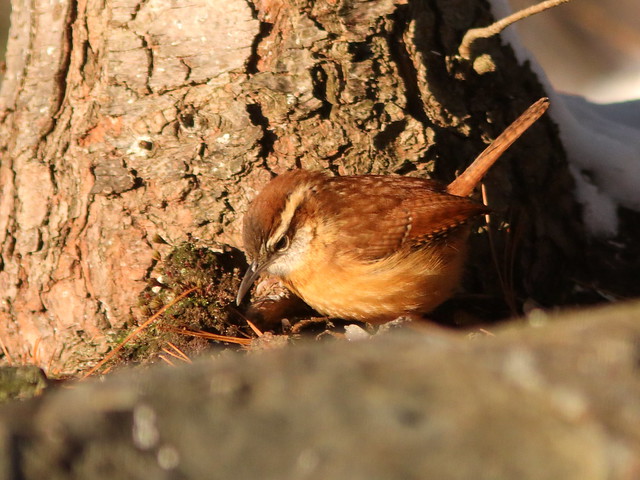


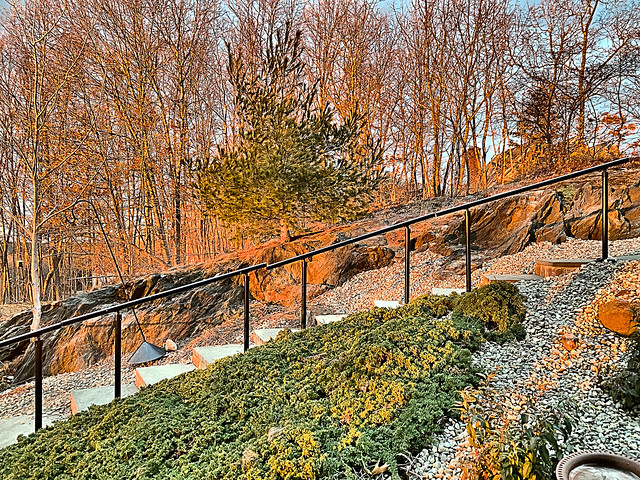



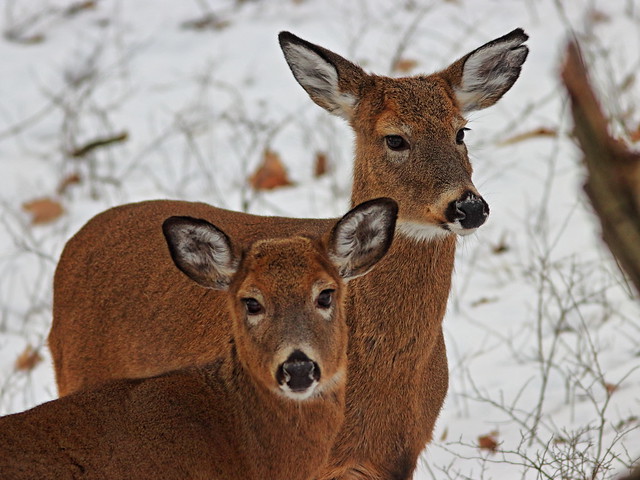




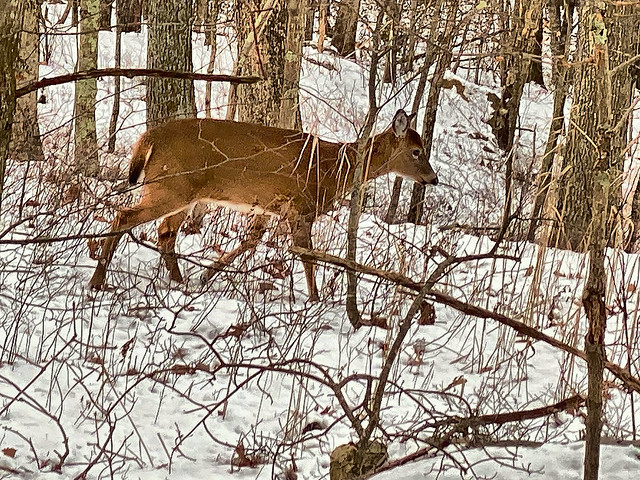
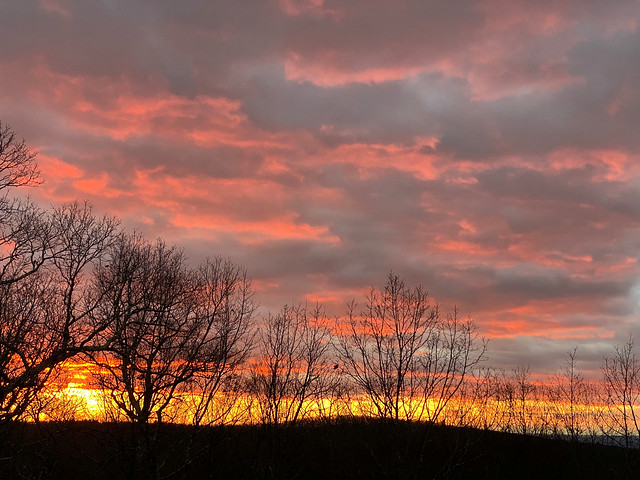
I am so impressed by the fact that these animals live so close by you! I never ever saw them in nature, only in captivity .
ReplyDeleteWe are a winter yard for, mostly, does. I love watching them. They amble about eating everything they can, which is tough with about a foot of snow. Great photos.
ReplyDeleteThank you, Ken, for some interesting information about deer. Not to mention the splendid photographs!
ReplyDeleteThe Carolina Wren is trying to figure out which way it needs to go to find Carolina!
Just to make you feel a small bit better, Florida is scheduled for BELOW FREEZING temperatures on Christmas Day!
We wish you and your family Peace and Joy for the holidays.
The bird looks so cute and petite. Yeah they all seem to survive the harsh winter. Amazing
ReplyDeleteThey're all beautiful - Happy Holidays!
ReplyDeleteOh my gosh, this was such a golden beautiful post. The warmth and beauty of winter, the animals and the crisp trees. I feel like I can see my breath after reading. That. That. Me of wandering in the woods after school and seeing dear very close by. Here in Hawaii I would need to go over to Kauai to see Axis deer. Wishing you magical holidays my friend
ReplyDeleteGreat photos of the Carolina Wren. You have really clean windows!!
ReplyDeleteI loved the comments on the deer and how they adapt to cold weather.
When I built pipelines in Texas back in the day and negotiating with landowners to buy right of way they were all adamant about not disturbing their stands of yaupon holly. They told me that it is really good winter protection for both their cattle and deer.
Sounds like fun to have a local deer population you can observe (and even name!). Have a very Merry Christmas!
ReplyDeleteBelieve it or not, as I am writing you it's below zero degr.! I remembered that when snow was laying on the ground (in N. California) the deer always disappeared, so you were lucky being able to see them!! Also love the capture of the stairs - great colors and design. A merry Christmas to you and your family Ken:)
ReplyDeleteDeer are beautiful to watch and they are plentiful on our farm. You have captured them so well.
ReplyDelete...Kenneth, I will have to stop back again. None of your pictures will load for me. Merry Christmas.
ReplyDeleteNice pictures. Cold weather and shorter days are also keeping by birding activity limited
ReplyDeleteI loved the photos of the deer. I do see them occasionally when out walking in the countryside but I can never get that close. Amazing that you can see your reflection in the doe's eye.
ReplyDeleteBeautiful sky.
ReplyDeleteExcellent photos. Happy Christmas and all the best for 2023, Cheers Diane
ReplyDeleteYour portraits of the Carolina wren have beautiful light and color. Your deer photos are also wonderful and quite intimate.
ReplyDeleteInteresting stories about your deer. The Carolina wren is adorable.
ReplyDeleteHello Ken,
ReplyDeleteLove your cute Carolina Wren, they are adorable birds. Awesome sightings and captures of the deer, the spotted fawn is so cute. Your last sky shot is gorgeous. We are having some bitter cold days, the wind chill is below zero. Stay safe and warm. Thank you for linking up your post and for the comments today and during the past year. Merry Christmas to you and your family. I wish you all the best in the New Year 2023.
Whata darling little bird. The deer's eye shot is the winner for me. Thanks for joining in #Allseasons. Happy Christmas to you. Back end Jan.
ReplyDeleteThat was me above heheh!
DeleteWhat a nice infornative post with some great captures I never knew that about Deers thanks for the info :-)
ReplyDeleteHave a deertastic week and New Year 👍 🍾🍾🍾
Happy New Year.
ReplyDeleteawesome observations of wild life.
ReplyDeleteI love deers, we also have a deer park in the city . Thanks for the detailed information about deers and fawns . Thanks for sharing with Garden affair.
ReplyDelete